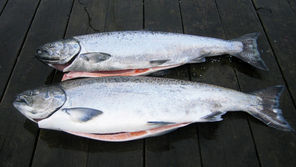forum
library
tutorial
contact

Idaho Power Begins Fall Flow Regime to Protect
Fall Chinook Redds Below Hells Canyon Dam
by Staff
Columbia Basin Bulletin, October 17, 2014
|
the film forum library tutorial contact |

|
Idaho Power Begins Fall Flow Regime to Protect
by Staff
|
 For the past 22 years, Boise-based Idaho Power has managed flows below its Hells Canyon Dam on the lower Snake River to provide stable conditions for spawning fall chinook salmon.
For the past 22 years, Boise-based Idaho Power has managed flows below its Hells Canyon Dam on the lower Snake River to provide stable conditions for spawning fall chinook salmon.
The autumn flow regime, which began Monday, is designed to help sustain a positive trend in fall chinook returns to the lower Snake and tributaries. Hells Canyon is the lowermost of three Idaho Power hydro projects in the Hells Canyon along the Idaho-Oregon border. Those dams block historic fall chinook spawning grounds upstream.
Flow control as well as habitat improvement and hatchery programs carried out by the company, the states of Idaho, Oregon and Washington, the Nez Perce tribe and federal agencies have helped reverse trends that resulted in a feeble Snake River fall chinook run being listed under the federal Endangered Species Act in 1992.
In 1991, Idaho Power said it counted a total of 55 chinook salmon nests, or "redds," in the survey area, which includes the Snake River between Hells Canyon Dam and Asotin, Wash., and the Grande Ronde, Imnaha, Clearwater and Salmon rivers, which flow into the Snake.
Last year, the number of redds surveyed topped 5,900, according to IPC.
The 2013 Snake River fall chinook salmon redd surveys were conducted cooperatively by IPC biologists, Nez Perce Tribe, U.S. Fish and Wildlife Service, Washington Department of Fish and Wildlife and Normandeau Associates, Inc. The summary report on those efforts can be found at: www.fpc.org/documents/fachin_planningteam/2013CooperativeFallChReddSummary.pdf
Last year was the 26th year that intensive, cooperative aerial surveys have been conducted in the Snake River and most major tributaries above Lower Granite Dam and 22nd year for ground surveys in tributaries downstream of Lower Granite Dam.
"The changes to our operations in Hells Canyon, along with the work done by Native American tribes, state and federal fish and wildlife managers and others have contributed to the success of the fall chinook in Hells Canyon," said Chris Randolph, Environmental Affairs director for Idaho Power.
The late fall redd counts this year could well match or exceed last year's totals. A record 57,867 adult fall chinook have been counted passing over the lower Snake's Lower Granite Dam in southeast Washington through Monday with 200-300 still being counted daily. The previous high annual total was 53,863 in 2013. The record dates back to 1975, the year Lower Granite was built.
Lower Granite is the eighth dam the spawners pass on their way up through the Columbia/Snake river system. Lower Granite is located 107.5 miles upstream from the Snake's southeast Washington confluence with the Columbia. Salmon passage on the Snake is blocked 140 river miles upstream of Lower Granite at Hells Canyon Dam. In between are tributaries such as the Grande Ronde, Imnaha and Salmon.
The Fall Chinook Program begins annually with controlling Brownlee Reservoir releases to provide flat flow conditions when fall chinook salmon establish redds. Brownlee Dam is the uppermost of the three Hells Canyon Complex dams, about 38 river miles from Hell Canyon Dam. The minimum flow level set below Hells Canyon during the spawning period is maintained until the fish emerge as "fry" in late spring or early summer. This helps ensure the redds remain underwater from spawning through fry emergence.
The salmon have been making their way back from the Pacific Ocean over the past several weeks and are starting to arrive in Hells Canyon.
The fall chinook flows that begin on Monday, Oct. 13, will be held at approximately 8,500 cubic feet per second until early- to mid-December. That's significantly lower than outflows were leading into the weekend. Boaters on the lower Snake River have been advised these changes could affect flows at Lime Point, and boaters are encouraged to be aware of changing river conditions.
Updated flow information is available on Idaho Power's website at idahopower.com/ourenvironment.
Idaho Power determines the spawning flow based upon several factors:
You can learn more about Idaho Power's Fall Chinook Program online at idahopower.com/ourenvironment.
Idaho Power is an electric utility that serves more than 500,000 customers throughout a 24,000-square-mile area in southern Idaho and eastern Oregon. With 17 low-cost hydroelectric projects as the core of its diverse generation portfolio, Idaho Power's residential, business and agricultural customers pay among the nation's lowest rates for electricity, the company says.
To learn more, visit idahopower.com or idacorpinc.com.
learn more on topics covered in the film
see the video
read the script
learn the songs
discussion forum
